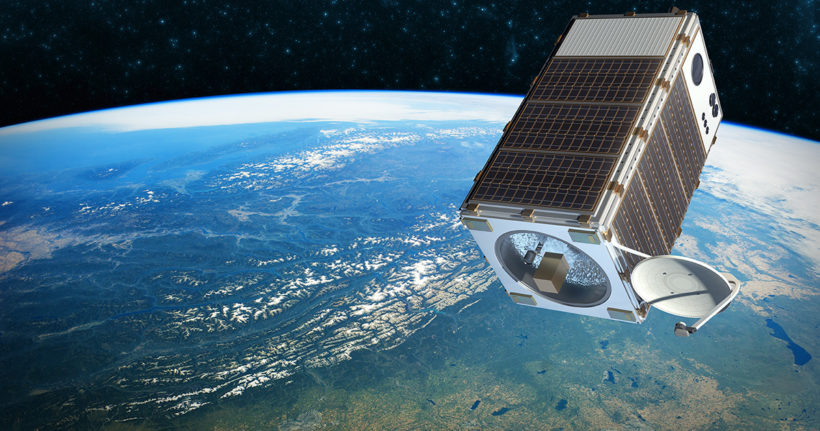 By MIRIAM ACZEL
By MIRIAM ACZEL
On April 11, Environmental Defense Fund (EDF) President Fred Krupp announced the organization’s plans to create and launch a new satellite to monitor and measure global methane emissions—from space.
Why Methane?
The ‘groundbreaking’ MethaneSAT plans were unveiled in a TED talk in Vancouver, BC.. The satellite will measure only emissions of methane, the powerful greenhouse gas responsible for roughly one quarter of the manmade global warming we currently experience. Methane is a particularly important cause of climate change because of its potency;while it is not as long-lasting in the atmosphere as carbon dioxide, it is “far more devastating” because it traps over 80 times more heat than carbon dioxide in the first twenty years after its release.
However, monitoring the odorless and colorless gas is complicated because it rises and disperses from the pollution source, making ground-based measurement difficult. Furthermore, studies which combine aerial and ground monitoring of methane have shown that the actual methane emissions are significantly higher than the levels reported by the Environmental Protection Agency.
Advantages of Monitoring from Space
Enter the MethaneSAT, which, as EDF climate scientist Steven Hamburg explained to NPR, “will be able to see where it’s happening [and] how much, across the globe — not just the big sources, but all the sources collectively, and understand the scale of the problem,” data that we don’t currently have. The ‘beer keg’ sized satellite is set to be launched in 3 years, and will look at methane emissions from industrial sources such as oil and gas operations as well as agricultural sources, wetlands, and landfill sites. According to Harvard University’s Steven Wofsy, the advantages of methane measuring from space mean that scientists are not required to obtain permission from oil and gas firms in order to monitor potential leaks in real-time. Furthermore, stopping methane leaks from oil and gas operations is relatively inexpensive, and even enables fossil fuel companies to sell more gas by preventing loss.
EDF’s efforts to monitor methane emissions are not new. Beginning in 2012, the organization launched their ‘largest research project to date,’ a $20 million, 5-year plan designed to measure the amounts and locations of methane leaks across the entire oil and gas supply chain. However, while this research assisted the EPA to correct national estimates of methane emissions, the work involved either ground-based local measurements or monitoring from airplane flyovers. Therefore, to scale up and monitor global methane emissions, reports show that satellite measurement technologies are preferable. And while there are some current governmental satellites that do measure methane, the resolution is not high enough to determine exactly where the sources are.
A Novel Solution
MethaneSAT is different because it is designed to monitor methane with high resolution in order to pinpoint emission sources. As Harvard professor Daniel J. Jacob recently said to the New York Times, “how can you do climate policy for methane if you don’t know where the sources are?” To address this, EDF will make the data available to the public, so that governments, industry, regulators and decision-makers can collaborate to address the emissions and mitigate climate change.
According to EDF, by focusing solely on methane emissions, MethaneSAT will be ‘less expensive and quicker to launch’ than other ‘multi-function’ satellites. The project is ‘about turning data into action,’ as it is intended to measure the sources and magnitude of methane emissions, as well as identify the largest potential emission reductions and the progress of the methane reductions.
As EDF President Krupp recently stated, this action is crucial: “cutting methane emissions from the global oil and gas industry is the single fastest thing we can do to help put the brakes on climate change right now, even as we continue to attack the carbon dioxide emissions most people are more familiar with.”
Wider Stakeholder Engagement
To accomplish this, EDF has engaged former CEO of Skybox Imaging, Tom Ingersoll, to help develop the MethaneSAT project. Ingersoll commented in a recent statement that “advances in space technology have put satellite projects within reach of any organization with the focus and the will… EDF has assembled the right partners with a strong vision and the ability to execute.” These partners include the Smithsonian Astophysical Observatory and Harvard University to complete the technical and scientific stages of the project, as well as ten major oil and gas companies from the Oil and Gas Climate Initiative. The project also involves collaboration with the Climate and Clean Air Coalition to produce new peer reviewed research to complement the free and publicly available data that the new satellite will provide.
MethaneSAT has received its initial funding from The Audacious Project, an initiative established by the TED conference organizers and backed by organizations such as the Bill and Melinda Gates Foundation. MethaneSAT is one of seven projects to receive financial from the TED initiative, and while the EDF has not disclosed the amount of funding, EDF President Krupp commented “it’s fair to say the satellite wouldn’t be happening except for The Audacious Project.”
One thing is certain: while it is still a few years before the novel satellite is launched, the level of collaboration across multiple stages and the publicly available data the project will provide is an important step in addressing climate change. As Krupp explained recently, “by providing reliable, fully transparent data on a worldwide scale, MethaneSAT will help transform a serious climate threat into a crucial opportunity.”
Editor’s note: This post originally appeared on the Environmental Law Institute’s blog Vibrant Environment: https://www.eli.org/vibrant-environment-blog/methanesat-monitoring-methane-emissions-space
Miriam Aczel is a President’s Scholar PhD Candidate at Imperial College London’s Centre for Environmental Policy. She researches international energy science and policy, with a focus on mitigation of environmental and health impacts of shale gas. She is based between London, Paris, and Washington DC.
Leaders in Energy is building a community of engaged leaders to create a sustainable energy system, economy, and world. The three main areas of action are the green economy, sustainable communities, and multigenerational leadership. With operations in Metro Washington DC, we’ve built a base that spans most major metropolitan areas and over 100 countries. More information is available at https://www.leadersinenergy.org and in the Leaders in Energy Research, Communication, Policies & Analysis (LERCPA) LinkedIn group.



Leave a Reply